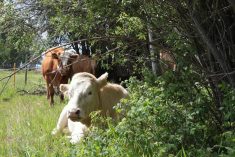Beef 911 An infection previously mostly found in dairy cattle is showing up in some western feedlots
It has come to my attention that “strawberry foot rot” or “hairy heel wart” or “Montellaros disease,” which was once considered a dairy disease is now making its way into feedlots in Eastern Canada. The disease is potentially caused by a treponema bacteria. The infection starts at the back of the hoof on or near the bulbs of the foot and works its way down. It causes a reddened, raised wart-like lesion surrounded by long hair, hence the descriptive names.
It can be confused by the true foot rot, which starts between the toes at the front of the hoof. Both conditions make cattle very sore but with strawberry foot rot the first cases go unnoticed because there is not much swelling evident at first.
Read Also

Mosquito-borne virus could be devastating to sheep breeding operations
Cache Valley virus, a mosquito-borne disease that infects small ruminants, could be a devastating hit to small operations.
Cattle generally contract this disease from constant exposure to moisture which is why some dairies have a high incidence of it. Feedlots can have outbreaks, especially when moist and cattle need to move through sloppy manure to get to feed bunks. The excessive moisture combined with those cattle immunosuppressed and abrasions to the feet will result in strawberry foot rot.
It is important to be recognized early, as the organism is sensitive to a fairly broad range of antibiotics. Tetracyclines are one of the families of antibiotics that are effective. They are injectable early, or wrapping the area in gauze soaked with tetracycline has also proven beneficial. Some dairy practitioners have even gone to spraying especially the backs of the feet with a tetracycline liquid. Treatments of topical low-strength iodine, chlorhexidine or peroxide have also at times been effective.
The cattle are extremely sore with this condition and often it affects both hind feet. Affected calves just want to lay around so subsequent weight gain is severely affected. In some feedlot calves the condition becomes so severe that shipping (once antibiotics are withdrawn) or humane euthanasia are the only solutions, so it is important to recognize it early.
If any foot trimming or hoof care is attempted on these cases, thoroughly disinfect and clean the instruments. Also clean yourself, as it may be zoonotic (transferrable to humans) and lead to infections of the hands and arms.
PreventionThe most effective preventive in the dairies has been first to maintain good hoof care and keeping the nutrition sound. Trace minerals such as zinc, calcium, phosphorus as well as vitamins A, D and E have been associated with good feet integrity. There is a vaccine in the U.S. against it which is somewhat effective apparently but it is not available in Canada yet.
The other preventives in dairies and that may need to be adapted for feedlots are footbaths with various products in them to routinely keep the treponema and other organisms at bay. Products such as formaldehyde (one gallon 37 per cent in 19 gallons of water), copper sulphate (five lbs. in nine gallons of water) or even dry footbaths of lime with tetracycline powder have been tried.
With footbaths it is critical that two long footbaths be strung together so the first one simply washes off organic material and the second is the treatment footbath. Footbaths must be long enough and wide and deep enough so the affected area is treated. Copper sulphate does not do well in organic material that is why the pre-wash is critical. Ideally it is best to have a space between water baths to allow the organic material to run off and upon exiting the water bath best to have the cattle in a dry pen for 15-30 minutes but I know that might be hard to implement. It’s best if the footbaths are in the nine- to 15-feet-long range, three feet wide and six inches deep. This way the entire foot is exposed and this may be repeated daily or some do it twice weekly.
I have personally seen a few Ontario feedlots where the footbaths were easily rigged up in the processing alley and the cattle could almost be trained to run through it after a couple of times. This seems to be keeping the organism at bay. Treatment rates vary from daily to a couple times a week until clinical signs subside. Going aggressively after the bad ones early with the tetracycline wraps is also worth the effort and the individual care will pull these through.
Dairy producers under the advice of their veterinarians are also spraying the bulbs of the feet with Lincospectin and avoiding the water baths but this may not be practical in a feedlot, though could be done to the clinical cases. Strawberry foot rot is also emerging as a significant disease in some feedlots out west, similar to the emerging sporadic condition necrosis of P3 documented recently.
We need to work on prevention by controlling wet conditions and communicate with each other advancements in either prevention or treatment of this very painful, contagious and production-limiting disease. Talk to your veterinarian and be ready to implement their best management practices to minimize the incidence of hairy heel wart in your feedlot or dairy.















